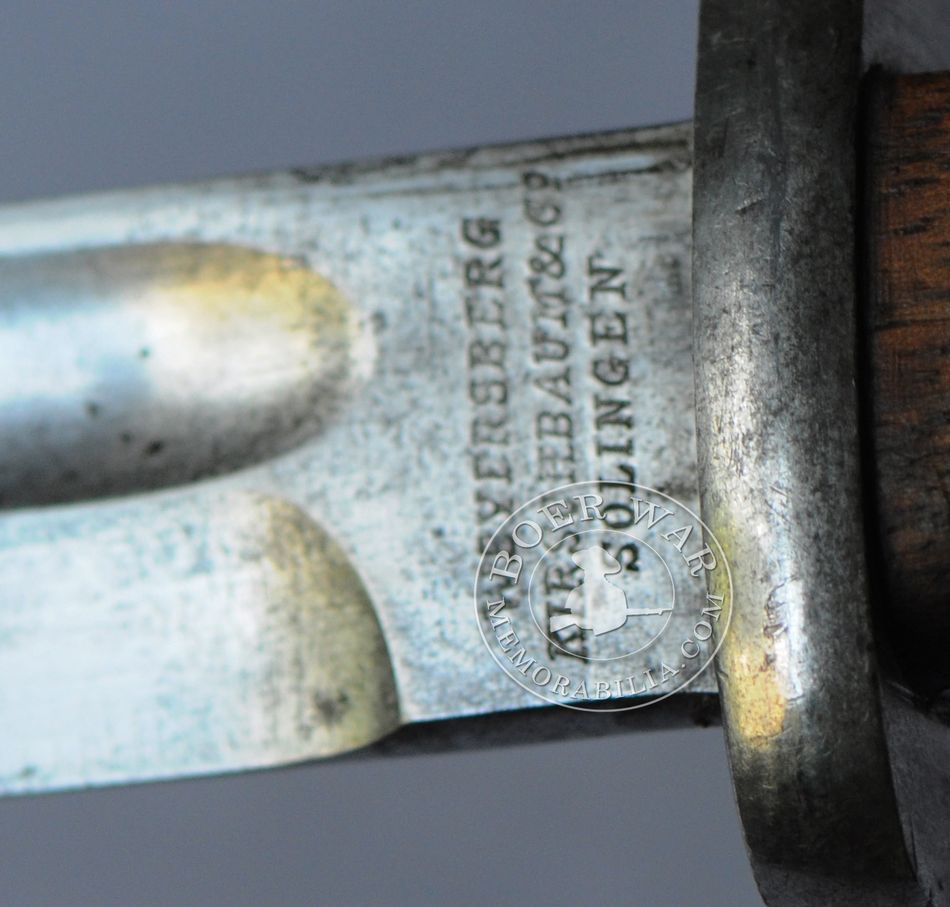|
View the embedded image gallery online at:
https://boerwarmemorabilia.com/index.php/memorabilia/military-insignia/item/100-mauser-bayonet-1-boer-forces#sigProId9bcd961dd2 |
Item Ref# KS6123
Mauser Bayonet 1 - Boer Forces
Brief description: Here is an extremely rare bayonet “used” by the Boer forces. It is also known as the Chilean Mauser bayonet, simply because most of these bayonets never made it into the ZAR. The Zuid Afrikaansche Republiek’s port (Lourenco Marques, now Maputo in Mozambique – former Greek colony) was blockaded by the British fleet and consequently the consignment was sent to Chile. The bayonet is modelled to fit the M95 Mauser rifle (1895, 7x57mm cal.) – the German manufactured weapon for the Boers. This bayonet will contain the manufacturers marking “Simson & Co.” as well as "Weyersburg Solingen". The scabbard is present, however the serial numbers do not match – the vast majority don’t (unfortunately). The bayonet was not a typical kit issue or weapon used by the Boers – uniformed or civilian. It was not an established or practised method of warfare, unlike in the British Empire’s methods of warfare. There are no reported incidents where Boers charged with fixed bayonets – which was a standard drill for British soldiers when fighting at close quarters. Material: Steel and wood Manufacturer: Simson & Co. - Germany Artist: N.A. Circa: 1895 Dimensions: tbc Weight: tbc Inscription: “Simson & Co.” as well as "Weyersburg Solingen". |

120mm Krupp QF Howitzer (Schellfeuer-Haubitze L/10)
Although a howitzer this gun outranged both British horse and field artillery. It can easily be identified by its stubby howitzer barrel and horizontal sliding breech block system, which opened to the right. As the Krupp breech did not provide as effective a gas seal, a cartridge case was used for obturation, i.e. to prevent the escape of gases to the rear. The cartridge case also allowed for a rapid rate of fire, but since the gun was still mounted on a rigid carriage with no buffer, this piece is better described as a quick loading or rapid firing howitzer. Smokeless powder was used, making it ideal for Boer camouflaged gun tactics.
Only four howitzers were imported in 1896 to form part of the Pretoria fortress armament. During the Siege of Ladysmith two of these were damaged during raids, one beyond repair. To replace it an exact copy was manufactured by Mr. Uggla at the NZASM (Dutch South African Railway Company) workshops in Pretoria. After the war this gun, inscribed: “Made by ZASM Workshops Pretoria to replace gun blown up by English night of 11.12.99 Ladysmith”, was found north of Belfast and sent to the Commanding Officer of the Rifle Depot at Winchester. Rumours exist that it survived, but this could not be confirmed.
ORANJE VRIJSTAAT ARTILLERIE CORPS/ Historical Study and Re-Enactment Group
| Scripture |
|
But the salvation of the righteous is from the LORD; He is their strength in time of trouble. Psalm 37:39 |

